wolfbirder
Well-known member
Just a short report - a late booking was acquired as I was in need of a bit of easy birding (or so I hoped) and a break from work. Ryan Air flights with just take on bag departing Manchester at around 2pm on 2nd February were around £35, with return flight departing 6th February at 11.40am costing about £60. Car hire with Cicar cost £100 for 4 days (no extras) and I had a Seat which was good and reliable. Hotel accommodation was a nightmare, with news recently stressing just how close to collapse the whole Canarian tourist scene is with too many tourists. Hence hotels are of a premium and raising prices at present. I could only find one at around £100 a night at Vecindario, the 'Vecindario Aeroporto hotel', which was just around ten miles along the main CG1 motorway from the airport. Location was everything, and essentially it had available car parking alongside, as well as a petrol station and a MacDonalds. In the evening I could have a meal and a few beers in the hotel bar whilst watching football. Not everyone's idea of paradise!
Anyone who knows the Canaries will know just how crowded Tenerife is, with nearly a million residents now, well I hadn't realised that Gran Canaria has nearly 900,000 residents, compared to Lanzarote with just 120,000 and Fuerteventura with 80,000. So the contrast between the islands is inevitable. And the amount of traffic on each island reflects the population size.
MapsMe app was also very helpful at various times on the island, as I often got lost. Whilst the CG1 and other attached motorways are good and fast, the roads into the mountains are slow and windy, and very narrow at times, so take great care. They are very busy at weekends too, with cyclists and motorbikes.
Bird wise, most birders will only pass through Gran Canaria to try to see Gan Canaria Blue Chaffinch. There are only 400 pairs, chiefly in two geographical mountain locations separated by several miles. Many birders go to the more northerly area at Llanos de la Pez, by Pico de Nieves which is more touristy and also more affected by adverse weather, whilst as Paul Chapman superbly highlighted in his recent report on here, several birds should be found by parking around El Juncal (below Roque Nublo) and walking 3-4 kms to the spot due SW, around Inagua and Casa Forestal de Pajonales.
E-bird sightings highlight the two obvious clusters below. You can pan in and out of sightings on E-Bird - go to 'explore' along the top navigation bar, then scroll down and select 'target species' where you must chose a country where it says 'Enter a region' - in this case type 'Canarias' and select 'Show target species', it gives you the full bird list. Scroll down to the species you want and select the small map symbol for any given species. Red markings indicate recent ones.
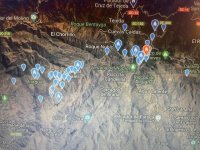
If you drill down to the Inagua area to the left, you can see a cluster by the GC605 road, where I hoped to connect (co-ordinates given below). The red recent sighting (not mine) indicates the spot I went to.
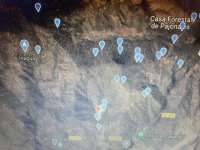
But there were 2 other birds that primarily drove me to come to Gran Canaria. A pair of Sudan Golden Sparrows have been over-wintering in hotel grounds at Playa del Ingles at Maspalomas. Who knows whether these are genuine birds, the fact that they are are a pair maybe suggests so, there is no sign of bling etc. A Sudan Golden Sparrow was also reported in coastal France last year, and a flock of 25 birds on Cape Verde, though this flock makes more sense. They can be found in quantity 150 miles across the sea in Morocco. It is hard to find information about the two birds here, or the thoughts of locals.
Even more outlandish, on 23rd January a pair of African Crakes had been released onto the reservoir at 'Charca de Maspalomas' after both being taken into care, I believe one was seen the following day but not since unfortunately. Nevertheless it at least made prospects of visiting the island a bit more mouth-watering than would perhaps otherwise have been the case.
After landing on the evening of 2nd February, I made my way (initially going the wrong way) to get to the hotel ideally situated by the CG1 motorway and with ample parking immediately to it, unlike many hotels in the main resorts where people crawl around for hours trying to park.
After breakfast on the 3rd February, I travelled fifteen miles to Playa del Ingles, Maspalomas arriving at 8am before most people were up, to look for the Sudan Golden Sparrow. A male by himself with binoculars can potentially look very dubious, especially when there is a children's playground nearby, so absolute care and discretion is necessary. I walked up and down Rue 'de Dinamarca' alongside hotel 'Parque Romantico' checking roadside trees and only saw a few Blackbirds and Spanish Sparrows, but there was gap in the vegetation right on the corner (27.74859, -15.57559) where I went over a low wall and walked quietly around the bushy wasteland area which was maybe an overspill garden waste area of the hotel, but seemed more like a cordoned-off unused section. I discreetly walked around the bushes and glimpsed the male Sudan Golden Sparrow with 2-3 Spanish Sparrows just ten metres from the corner where I accessed, standing out like a beacon. The 3-4 birds then flew out of the bush and across the road into a nearby roadside tree just twenty metres away. On the photograph below, the gap in the bushes is right by the red 'no entry' sign, and it then flew out of bushes just inside that area, to the first tree on the left of the road. But it can get anywhere along this road for the next hundred metres. Anyway, that was my main target to be honest. A lovely looking bird.
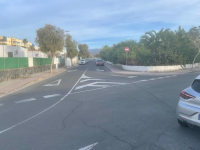
I then drove to nearby Charca de Maspalomas, parking at 27.74582, -15.59593. This free parking spot was great for access to the best birding spot on the island at the Charca, necessitating a walk across a footbridge and then a ten-minute walk alongside a reed-lined, fenced-off channel where any African Crake would likely be - and frustratingly nearly always out of view! This path eventually leads out to an opening overlooking the estuary on your left. and good views can be enjoyed from here at your leisure. Again, morning visits are best before the area gets very busy with tourists. Monk and Ringed-necked Parakeets screech overhead between the palm trees, and a few Plain Swifts were 'zipping' around. 2 Glossy Ibis, Greenshank, Ruff, Little Ringed Plover, 6 Black-winged Stilt, 2 Moorhen, 3 Little Egret, 3 Grey Heron, and Hoopoe were seen but no sign of the African Crake, but the sort of ditches it would likely favour were clearly well out of view. It could still be there, who knows? The camel ride area is back by the car park, and the adjacent sand-dunes can be accessed from there to look for Spectacled Warbler, but they are extensive.
- and frustratingly nearly always out of view! This path eventually leads out to an opening overlooking the estuary on your left. and good views can be enjoyed from here at your leisure. Again, morning visits are best before the area gets very busy with tourists. Monk and Ringed-necked Parakeets screech overhead between the palm trees, and a few Plain Swifts were 'zipping' around. 2 Glossy Ibis, Greenshank, Ruff, Little Ringed Plover, 6 Black-winged Stilt, 2 Moorhen, 3 Little Egret, 3 Grey Heron, and Hoopoe were seen but no sign of the African Crake, but the sort of ditches it would likely favour were clearly well out of view. It could still be there, who knows? The camel ride area is back by the car park, and the adjacent sand-dunes can be accessed from there to look for Spectacled Warbler, but they are extensive.
Hundreds of Feral Pigeons are situated around the camel pen, as well as 30-40 Collared Doves, and on both my visits I found 2 'putative' African Collared Doves with white UTCs, but these are still contentious as there is likely to be much hybridisation so are not recognised as a full species by Spanish authorities, though IOC do recognise them. Study of the Eurasian and African Collared Dove species may not float your boat, and add into the equation the domesticated paler Barbary Dove, of which I saw one individual. A few photos to highlight the comparison.
Undertail coverts of Eurasian Collared Dove below - grey with white undertail: -
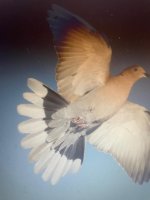
In contrast, note white UTCs of putative African Collared Dove (note the tail is actually also white despite the sun angle producing a false grey colouring here): -
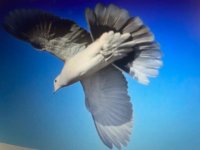
With the heat of the day I returned to the hotel, and late afternoon, drove the track from my hotel at Vecindario to the coast at Barranquillo, a journey of just a mile. I walked the barren, bird-less coast for an hour and came across a single Gull-billed Tern, a bit of a treat.
On 4th February, I set out in the dark up into the mountains to Inagua, arriving on the GC605 at 9am by a spot where there are 3 signposts at 27.92756, -15.67770, indicating that I was at the correct spot to park at 27.92756, -15.67770. Behind the round no vehicle access sign is a white square sign, and just visible on the bank on the left is a reddish square sign barely visible here. There is a parking layby holding 2 cars just behind where I took this photograph from plus some room to the side as seen here, if the two spots are already taken.
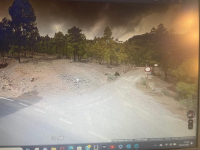
Then walk 500 metres north along the main track and slightly uphill to 3 white uninhabited buildings belonging to the local water board at 27931.58,-15.67790. E-bird shows this as a bit of a hotspot, though over two hours I only saw a single male Gran Canaria Blue Chaffinch, and in fact only 1 or 2 are often reported there. For me as a lazy lightweight birder, it was an easy alternative to walking the 3-4 kms along Paul Chapman's more ornithologically-rewarding track, which I hoped I would be able to avoid. Anyway, I walked around the white buildings and also saw male Great Spotted Woodpecker, Kestrel, Canary, and several African Blue Tits and Canary Islands Chiffchaffs, with Buzzard overhead. The silent Blue Chaffinch I eventually saw here was ringed, but was very immobile once located, somewhat lumbering around and not really catching the eye with its movement. But views down to ten metres were excellent. Overall, this was a lovely short walk, very quiet and peaceful, and Inagua offers a better experience in my view, and is often sheltered from the strong winds that occur ten miles away at Llanos de la Pez. No guarantees here however, and you may be better off walking the longer route recommended in Paul's report, where he had a few individuals. That path actually eventually connects to this one as you can see by studying E-Bird and Googlemaps.
After tea, I checked out a local park at Park de la Paz in Vecindario, hoping to find 'superbus' Robin, but it was very crowded with families, and I only saw Greenfinch, Goldfinch, Blue Tits, Chiffchaffs, and many Blackbirds.
On 5th February, my last full day, I revisited 'Charca de Maspalomas' once again early morning, where I again found 2 'putative' African Collared Doves by the camels (same ones?), and during the walk down to the estuary, parakeets and a Hoopoe showed well. Again, there was no sign of the African Crake, and I met two birders there who had also failed to connect. I enjoyed a productive couple of hours, noting Squacco Heron, Black-crowned Night Heron, 3 Grey Herons, 6 Little Egrets, 14 Cattle Egrets, 5 Glossy Ibis, Common Sandpiper, 2 Little Ringed Plover, Greenshank, 6 Black-winged Stilts, Redshank, 4 Moorhens, 3 Ruddy Shelducks, 15 Monk Parakeets, 2 Ringed-necked Parakeets, 2 Plain Swifts, 2 Swallows, and several Spanish Sparrows. This is arguably the most-birdy spot on the island, though that is not saying much really. Hotels here are premium cost, as it is a very nice resort.
Nearby, I checked out some water work pools just off the GC1 at Aldea Blanca but these only revealed 2 Little Ringed Plovers, Greenshank, 2 Common Sandpipers, 2 Ruddy Shelducks, and my only Desert Grey Shrike. An Island Darter was also seen here but it was very barren and I failed to find any Spectacled Warblers in the barren scrub.
Around lunchtime, I drove north along the GC1, onto GC3 then GC4, and finally the GC110, where I visited the signposted Jardin Botanico (official map name is Jardin Botanico Viera Y Clavijo) just north of Tavira Alta. This is a wonderful sheltered location which has a car park and free entrance. As I ambled around over two hours, Monarch butterflies floated around, tilting one way then the other like harriers. There were lots of smaller white butterflies, but I think this is a Monarch.
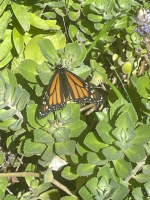
Canaries, African Blue Tits, Canary Islands Chiffchaffs, Blackbirds, Collared Doves all abound here, but 'superbus' Robin can be found easily, I had a least 6 of them, sounding totally different to our nominate species and indeed different from those on Tenerife. With their white bellies, they look very different to our birds, but can be tricky here on Gran Canaria, so this is an excellent spot if you want to see this species. Surely a potential split and full species status is pending, as with the Chaffinches, not that I am any sort of taxonomic expert of course. A Common Waxbill, Blackcaps, and Sardinian Warbler were also seen briefly here. A poor shot of a 'superbus' Robin below: -
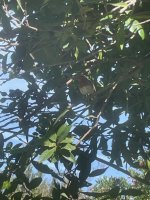
Then it was back to the hotel for beer and food, and news that Wolves had won at Chelsea for the first time since I was a teenager, I'm now 61 ! A great day (sorry Blues fans).
I checked out on the morning of the 6th February, and went to photograph an old Douglas DC-7 piston airliner I noticed alongside the road, before driving to the airport. Sorry, I'm a bit of a plane enthusiast, well if they are antiques as they held some character back then!
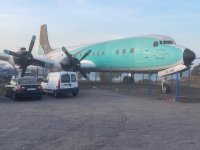
So that is it - an easy trip where I rested a lot from the heat, though at maximum it only reached 25 degrees celsius. I found the stunning male Sudan Golden Sparrow and also the Gran Canaria Blue Chaffinch, as well as putative African Collared Dove, but sadly no African Crake for me. Just 45 species seen in total, but it was relatively successful overall. I didn't try at all for Laurel Pigeon nor try very hard for Spectacled Warbler, as I had seen plenty on other nearby islands, and apart from an hour late pm from the coast near my hotel, I did not dedicate time to sea-watching. Even then, there were no shearwaters or anything else, except the single tern I mentioned. Indeed, are there any reputed sea-watching spots on Gran Canaria?
Ornithologically, Gran Canaria is not that rewarding in isolation, but with this relatively easy rather-special Sparrow still present, and the rather-difficult endemic Gran Canaria Blue Chaffinch, it's may be worth a short visit or a bit of winter-sun.
Anyone who knows the Canaries will know just how crowded Tenerife is, with nearly a million residents now, well I hadn't realised that Gran Canaria has nearly 900,000 residents, compared to Lanzarote with just 120,000 and Fuerteventura with 80,000. So the contrast between the islands is inevitable. And the amount of traffic on each island reflects the population size.
MapsMe app was also very helpful at various times on the island, as I often got lost. Whilst the CG1 and other attached motorways are good and fast, the roads into the mountains are slow and windy, and very narrow at times, so take great care. They are very busy at weekends too, with cyclists and motorbikes.
Bird wise, most birders will only pass through Gran Canaria to try to see Gan Canaria Blue Chaffinch. There are only 400 pairs, chiefly in two geographical mountain locations separated by several miles. Many birders go to the more northerly area at Llanos de la Pez, by Pico de Nieves which is more touristy and also more affected by adverse weather, whilst as Paul Chapman superbly highlighted in his recent report on here, several birds should be found by parking around El Juncal (below Roque Nublo) and walking 3-4 kms to the spot due SW, around Inagua and Casa Forestal de Pajonales.
E-bird sightings highlight the two obvious clusters below. You can pan in and out of sightings on E-Bird - go to 'explore' along the top navigation bar, then scroll down and select 'target species' where you must chose a country where it says 'Enter a region' - in this case type 'Canarias' and select 'Show target species', it gives you the full bird list. Scroll down to the species you want and select the small map symbol for any given species. Red markings indicate recent ones.

If you drill down to the Inagua area to the left, you can see a cluster by the GC605 road, where I hoped to connect (co-ordinates given below). The red recent sighting (not mine) indicates the spot I went to.

But there were 2 other birds that primarily drove me to come to Gran Canaria. A pair of Sudan Golden Sparrows have been over-wintering in hotel grounds at Playa del Ingles at Maspalomas. Who knows whether these are genuine birds, the fact that they are are a pair maybe suggests so, there is no sign of bling etc. A Sudan Golden Sparrow was also reported in coastal France last year, and a flock of 25 birds on Cape Verde, though this flock makes more sense. They can be found in quantity 150 miles across the sea in Morocco. It is hard to find information about the two birds here, or the thoughts of locals.
Even more outlandish, on 23rd January a pair of African Crakes had been released onto the reservoir at 'Charca de Maspalomas' after both being taken into care, I believe one was seen the following day but not since unfortunately. Nevertheless it at least made prospects of visiting the island a bit more mouth-watering than would perhaps otherwise have been the case.
After landing on the evening of 2nd February, I made my way (initially going the wrong way) to get to the hotel ideally situated by the CG1 motorway and with ample parking immediately to it, unlike many hotels in the main resorts where people crawl around for hours trying to park.
After breakfast on the 3rd February, I travelled fifteen miles to Playa del Ingles, Maspalomas arriving at 8am before most people were up, to look for the Sudan Golden Sparrow. A male by himself with binoculars can potentially look very dubious, especially when there is a children's playground nearby, so absolute care and discretion is necessary. I walked up and down Rue 'de Dinamarca' alongside hotel 'Parque Romantico' checking roadside trees and only saw a few Blackbirds and Spanish Sparrows, but there was gap in the vegetation right on the corner (27.74859, -15.57559) where I went over a low wall and walked quietly around the bushy wasteland area which was maybe an overspill garden waste area of the hotel, but seemed more like a cordoned-off unused section. I discreetly walked around the bushes and glimpsed the male Sudan Golden Sparrow with 2-3 Spanish Sparrows just ten metres from the corner where I accessed, standing out like a beacon. The 3-4 birds then flew out of the bush and across the road into a nearby roadside tree just twenty metres away. On the photograph below, the gap in the bushes is right by the red 'no entry' sign, and it then flew out of bushes just inside that area, to the first tree on the left of the road. But it can get anywhere along this road for the next hundred metres. Anyway, that was my main target to be honest. A lovely looking bird.

I then drove to nearby Charca de Maspalomas, parking at 27.74582, -15.59593. This free parking spot was great for access to the best birding spot on the island at the Charca, necessitating a walk across a footbridge and then a ten-minute walk alongside a reed-lined, fenced-off channel where any African Crake would likely be
Hundreds of Feral Pigeons are situated around the camel pen, as well as 30-40 Collared Doves, and on both my visits I found 2 'putative' African Collared Doves with white UTCs, but these are still contentious as there is likely to be much hybridisation so are not recognised as a full species by Spanish authorities, though IOC do recognise them. Study of the Eurasian and African Collared Dove species may not float your boat, and add into the equation the domesticated paler Barbary Dove, of which I saw one individual. A few photos to highlight the comparison.
Undertail coverts of Eurasian Collared Dove below - grey with white undertail: -

In contrast, note white UTCs of putative African Collared Dove (note the tail is actually also white despite the sun angle producing a false grey colouring here): -

With the heat of the day I returned to the hotel, and late afternoon, drove the track from my hotel at Vecindario to the coast at Barranquillo, a journey of just a mile. I walked the barren, bird-less coast for an hour and came across a single Gull-billed Tern, a bit of a treat.
On 4th February, I set out in the dark up into the mountains to Inagua, arriving on the GC605 at 9am by a spot where there are 3 signposts at 27.92756, -15.67770, indicating that I was at the correct spot to park at 27.92756, -15.67770. Behind the round no vehicle access sign is a white square sign, and just visible on the bank on the left is a reddish square sign barely visible here. There is a parking layby holding 2 cars just behind where I took this photograph from plus some room to the side as seen here, if the two spots are already taken.

Then walk 500 metres north along the main track and slightly uphill to 3 white uninhabited buildings belonging to the local water board at 27931.58,-15.67790. E-bird shows this as a bit of a hotspot, though over two hours I only saw a single male Gran Canaria Blue Chaffinch, and in fact only 1 or 2 are often reported there. For me as a lazy lightweight birder, it was an easy alternative to walking the 3-4 kms along Paul Chapman's more ornithologically-rewarding track, which I hoped I would be able to avoid. Anyway, I walked around the white buildings and also saw male Great Spotted Woodpecker, Kestrel, Canary, and several African Blue Tits and Canary Islands Chiffchaffs, with Buzzard overhead. The silent Blue Chaffinch I eventually saw here was ringed, but was very immobile once located, somewhat lumbering around and not really catching the eye with its movement. But views down to ten metres were excellent. Overall, this was a lovely short walk, very quiet and peaceful, and Inagua offers a better experience in my view, and is often sheltered from the strong winds that occur ten miles away at Llanos de la Pez. No guarantees here however, and you may be better off walking the longer route recommended in Paul's report, where he had a few individuals. That path actually eventually connects to this one as you can see by studying E-Bird and Googlemaps.
After tea, I checked out a local park at Park de la Paz in Vecindario, hoping to find 'superbus' Robin, but it was very crowded with families, and I only saw Greenfinch, Goldfinch, Blue Tits, Chiffchaffs, and many Blackbirds.
On 5th February, my last full day, I revisited 'Charca de Maspalomas' once again early morning, where I again found 2 'putative' African Collared Doves by the camels (same ones?), and during the walk down to the estuary, parakeets and a Hoopoe showed well. Again, there was no sign of the African Crake, and I met two birders there who had also failed to connect. I enjoyed a productive couple of hours, noting Squacco Heron, Black-crowned Night Heron, 3 Grey Herons, 6 Little Egrets, 14 Cattle Egrets, 5 Glossy Ibis, Common Sandpiper, 2 Little Ringed Plover, Greenshank, 6 Black-winged Stilts, Redshank, 4 Moorhens, 3 Ruddy Shelducks, 15 Monk Parakeets, 2 Ringed-necked Parakeets, 2 Plain Swifts, 2 Swallows, and several Spanish Sparrows. This is arguably the most-birdy spot on the island, though that is not saying much really. Hotels here are premium cost, as it is a very nice resort.
Nearby, I checked out some water work pools just off the GC1 at Aldea Blanca but these only revealed 2 Little Ringed Plovers, Greenshank, 2 Common Sandpipers, 2 Ruddy Shelducks, and my only Desert Grey Shrike. An Island Darter was also seen here but it was very barren and I failed to find any Spectacled Warblers in the barren scrub.
Around lunchtime, I drove north along the GC1, onto GC3 then GC4, and finally the GC110, where I visited the signposted Jardin Botanico (official map name is Jardin Botanico Viera Y Clavijo) just north of Tavira Alta. This is a wonderful sheltered location which has a car park and free entrance. As I ambled around over two hours, Monarch butterflies floated around, tilting one way then the other like harriers. There were lots of smaller white butterflies, but I think this is a Monarch.

Canaries, African Blue Tits, Canary Islands Chiffchaffs, Blackbirds, Collared Doves all abound here, but 'superbus' Robin can be found easily, I had a least 6 of them, sounding totally different to our nominate species and indeed different from those on Tenerife. With their white bellies, they look very different to our birds, but can be tricky here on Gran Canaria, so this is an excellent spot if you want to see this species. Surely a potential split and full species status is pending, as with the Chaffinches, not that I am any sort of taxonomic expert of course. A Common Waxbill, Blackcaps, and Sardinian Warbler were also seen briefly here. A poor shot of a 'superbus' Robin below: -

Then it was back to the hotel for beer and food, and news that Wolves had won at Chelsea for the first time since I was a teenager, I'm now 61 ! A great day (sorry Blues fans).
I checked out on the morning of the 6th February, and went to photograph an old Douglas DC-7 piston airliner I noticed alongside the road, before driving to the airport. Sorry, I'm a bit of a plane enthusiast, well if they are antiques as they held some character back then!

So that is it - an easy trip where I rested a lot from the heat, though at maximum it only reached 25 degrees celsius. I found the stunning male Sudan Golden Sparrow and also the Gran Canaria Blue Chaffinch, as well as putative African Collared Dove, but sadly no African Crake for me. Just 45 species seen in total, but it was relatively successful overall. I didn't try at all for Laurel Pigeon nor try very hard for Spectacled Warbler, as I had seen plenty on other nearby islands, and apart from an hour late pm from the coast near my hotel, I did not dedicate time to sea-watching. Even then, there were no shearwaters or anything else, except the single tern I mentioned. Indeed, are there any reputed sea-watching spots on Gran Canaria?
Ornithologically, Gran Canaria is not that rewarding in isolation, but with this relatively easy rather-special Sparrow still present, and the rather-difficult endemic Gran Canaria Blue Chaffinch, it's may be worth a short visit or a bit of winter-sun.
Last edited:





